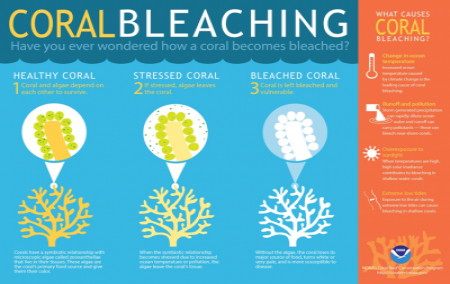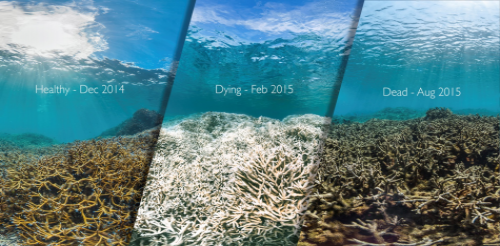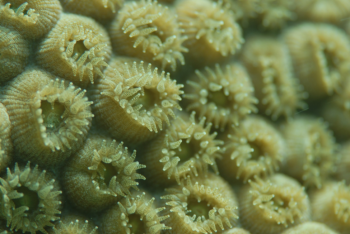Reef temperature wrangler
Coral reefs often go unnoticed because they’re underwater; but even though we don’t regularly pay much attention to them, they’re an extremely important part of our everyday lives. Coral reefs have been estimated to provide support for over a quarter of all marine species and this extreme biodiversity makes them a frequent source of discovery for new medicines that can help fight cancer and other diseases. They also protect our coastlines from storm surges, and provide millions of individuals with a source food and income. These are a few of the reasons why the world’s coral reefs are valued at nearly 10 trillion dollars.
Coral Crisis
Unfortunately, we’re in a bit of a coral crisis. Recently we’ve been losing a frightening amount of the world’s coral reefs. The vast majority of the reefs (80%) in the Caribbean, and over half in the Indo-Pacific region have already been lost. This large decline in reefs is predominantly caused by coral bleaching:
Inside the coral live tiny photosynthetic plants – or algae called zooxanthellae - that provide the coral with food and its beautiful color, but when the water around the coral becomes too warm, the algae are forced out of the coral, leaving behind the coral’s white calcium carbonate skeleton, giving it a “bleached” appearance. If the coral goes too long without the support from the algae, they starve, become vulnerable to disease, and frequently die.
 Figure 2. PRocess and causes of coral bleaching. Photo: NOAA.
Figure 2. PRocess and causes of coral bleaching. Photo: NOAA.It is expected that as global warming continues to cause water temperatures to rise, coral bleaching will become more frequent and severe. By 2050, it’s projected that between 91 and 98% of the world’s coral reefs will be exposed to bleaching-level thermal stress on an annual basis.
Coral Reef Monitoring
Fortunately, there is a lot of great work being done to address this important issue. The South Florida and Caribbean Network (SFCN) of the National Park Service’s Inventory and Monitoring Program has been monitoring water temperature and coral bleaching since the late 1980’s and have collected an amazing supply of data. Through an internship with the Young Leaders in Climate Change (YLCC), I had the opportunity to work with SFCN as a data analyst to make sense of their data. Below are a few of my most important findings.
 Figure 3. Stages of coral bleaching. Photo: The Ocean Agency / XL Catlin Seaview / Richard Vevers)
Figure 3. Stages of coral bleaching. Photo: The Ocean Agency / XL Catlin Seaview / Richard Vevers)
Water Temperature Trends and Coral Bleaching Forecasts
Water temperature has been increasing in the Virgin Islands – one location where SFCN monitors coral bleaching – since the project was started in 1988. Although this long-term trend is expected to continue into the future, it doesn’t suggest that water temperatures will increase consistently on a year-to-year basis.
In order to anticipate what water temperatures can be expected in the near future, we can use past data to create 24-month water temperature forecasts. Since water temperature and coral bleaching have a very strong relationship, our forecast is helpful because it lets us anticipate whether a coming year will be good or bad for reefs and if there will be more or less bleaching. For example, our forecasts for the Virgin Islands found that 2017 will be slightly cooler than previous years, with a relatively low amount of bleaching predicted (22%) - good news for the coral reefs in that region. This type of foresight allows for adaptive resource management and more effective monitoring of coral bleaching, but much more needs to be done to address the issue.
What is being done and what you can do to help
Scientists and researchers around the world are working on many different projects to help minimize the impact of coral bleaching. These projects include: coral nurseries and reef restoration initiatives, studying the factors that increase coral’s susceptibility to bleaching, and even genetically modifying algae to be resistant to warmer ocean temperatures.
Although these researchers’ are making important contributions, they won’t be able to fix the problem alone. Saving our coral reefs is going to require many people making small efforts to help battle coral bleaching and global warming. Separately, these small individual efforts may seem miniscule, but if enough people make them, they will have a large impact overall. After all, it takes millions of individual coral polyps to build a reef.
 Figure 4. Coral polyps. Photo: SFCN.
Figure 4. Coral polyps. Photo: SFCN.
Fortunately, one of the most frequent questions I get when I talk about coral bleaching is “what can I do to help?” Here are a few of the many ways you can help save our reefs:
- Reduce your carbon footprint.
- Inform others about coral bleaching to spread awareness.
- Support organizations dedicated to conserving coral reefs.
- Contact your government officials about implementing laws to preserve marine ecosystems.
- Marine protected areas help mitigate coral bleaching.
- Reduce water consumption to minimize runoff pollution
- If you live near the coast, volunteer for cleanups or participate in citizen science initiatives to report cases of coral bleaching
Resources
- Coral reef conservation organizations
- Coral bleaching citizen science
- Netflix documentary
- NOAA’s Coral Reef Watch Program
NOTE: Comments will be visible to the public. Before commenting for the first time, please review the ECCF's Editorial Policy.


 Brandon Araujo
Brandon Araujo
Add comment